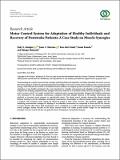Por favor, use este identificador para citar o enlazar a este item:
http://hdl.handle.net/10261/206137COMPARTIR / EXPORTAR:
 SHARE SHARE
 CORE
BASE CORE
BASE
|
|
| Visualizar otros formatos: MARC | Dublin Core | RDF | ORE | MODS | METS | DIDL | DATACITE | |

| Título: | Motor Control System for Adaptation of Healthy Individuals and Recovery of Poststroke Patients: A Case Study on Muscle Synergies |
Autor: | Alnajjar, Fady; Moreno, Juan Camilo CSIC ORCID ; Ozaki, K. I.; Kondo, I.; Shimoda, S. | Fecha de publicación: | 2019 | Editor: | Hindawi Publishing Corporation | Citación: | Neural Plasticity 2019 (2019) | Resumen: | Understanding the complex neuromuscular strategies underlying behavioral adaptation in healthy individuals and motor recovery after brain damage is essential for gaining fundamental knowledge on the motor control system. Relying on the concept of muscle synergy, which indicates the number of coordinated muscles needed to accomplish specific movements, we investigated behavioral adaptation in nine healthy participants who were introduced to a familiar environment and unfamiliar environment. We then compared the resulting computed muscle synergies with those observed in 10 moderate-stroke survivors throughout an 11-week motor recovery period. Our results revealed that computed muscle synergy characteristics changed after healthy participants were introduced to the unfamiliar environment, compared with those initially observed in the familiar environment, and exhibited an increased neural response to unpredictable inputs. The altered neural activities dramatically adjusted through behavior training to suit the unfamiliar environment requirements. Interestingly, we observed similar neuromuscular behaviors in patients with moderate stroke during the follow-up period of their motor recovery. This similarity suggests that the underlying neuromuscular strategies for adapting to an unfamiliar environment are comparable to those used for the recovery of motor function after stroke. Both mechanisms can be considered as a recall of neural pathways derived from preexisting muscle synergies, already encoded by the brain's internal model. Our results provide further insight on the fundamental principles of motor control and thus can guide the future development of poststroke therapies. | Versión del editor: | http://dx.doi.org/10.1155/2019/8586416 | URI: | http://hdl.handle.net/10261/206137 | DOI: | 10.1155/2019/8586416 | Identificadores: | doi: 10.1155/2019/8586416 issn: 1687-5443 |
| Aparece en las colecciones: | (IC) Artículos |
Ficheros en este ítem:
| Fichero | Descripción | Tamaño | Formato | |
|---|---|---|---|---|
| Motor Control System for Adaptation of Healthy Individuals and Recovery of Poststroke Patients- A Case Study on Muscle Synergies.pdf | 2,39 MB | Adobe PDF |  Visualizar/Abrir |
CORE Recommender
PubMed Central
Citations
3
checked on 21-may-2024
SCOPUSTM
Citations
12
checked on 18-may-2024
WEB OF SCIENCETM
Citations
5
checked on 23-feb-2024
Page view(s)
106
checked on 21-may-2024
Download(s)
97
checked on 21-may-2024
Google ScholarTM
Check
Altmetric
Altmetric
Artículos relacionados:
NOTA: Los ítems de Digital.CSIC están protegidos por copyright, con todos los derechos reservados, a menos que se indique lo contrario.
